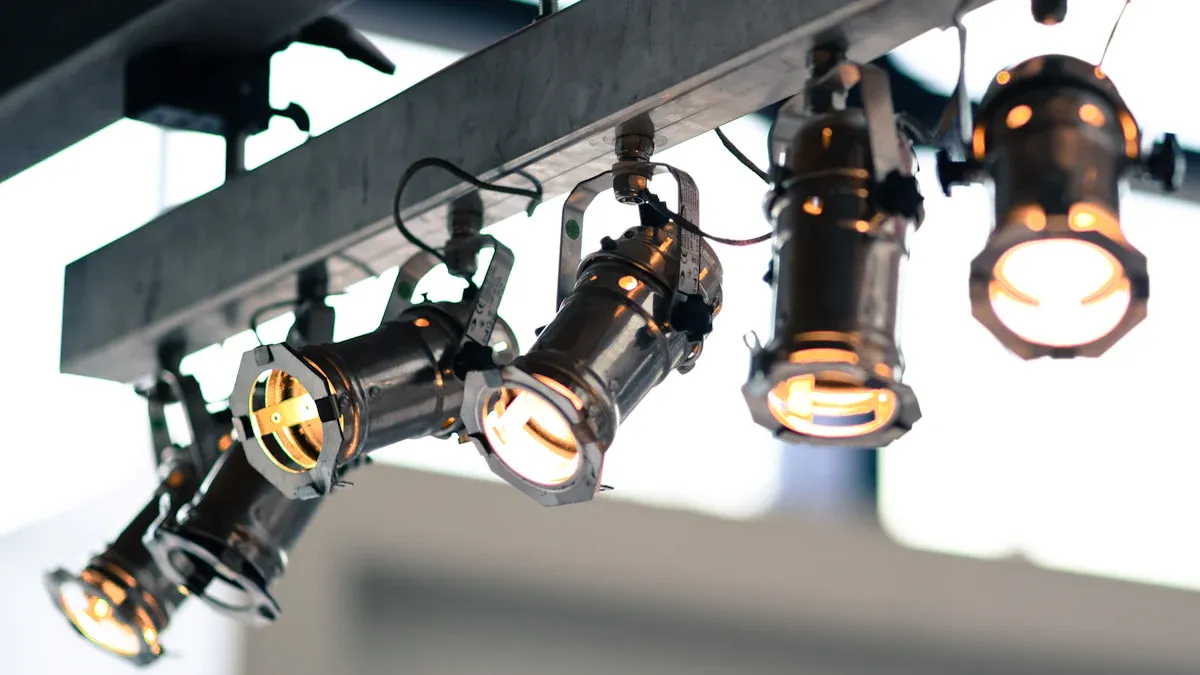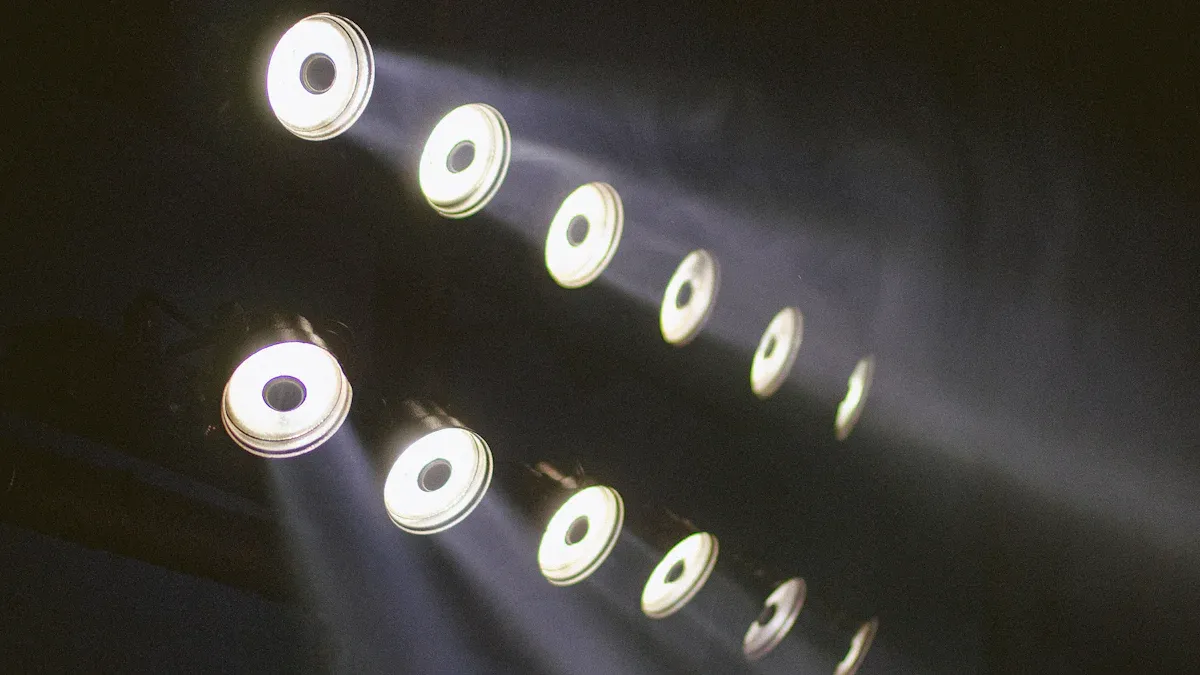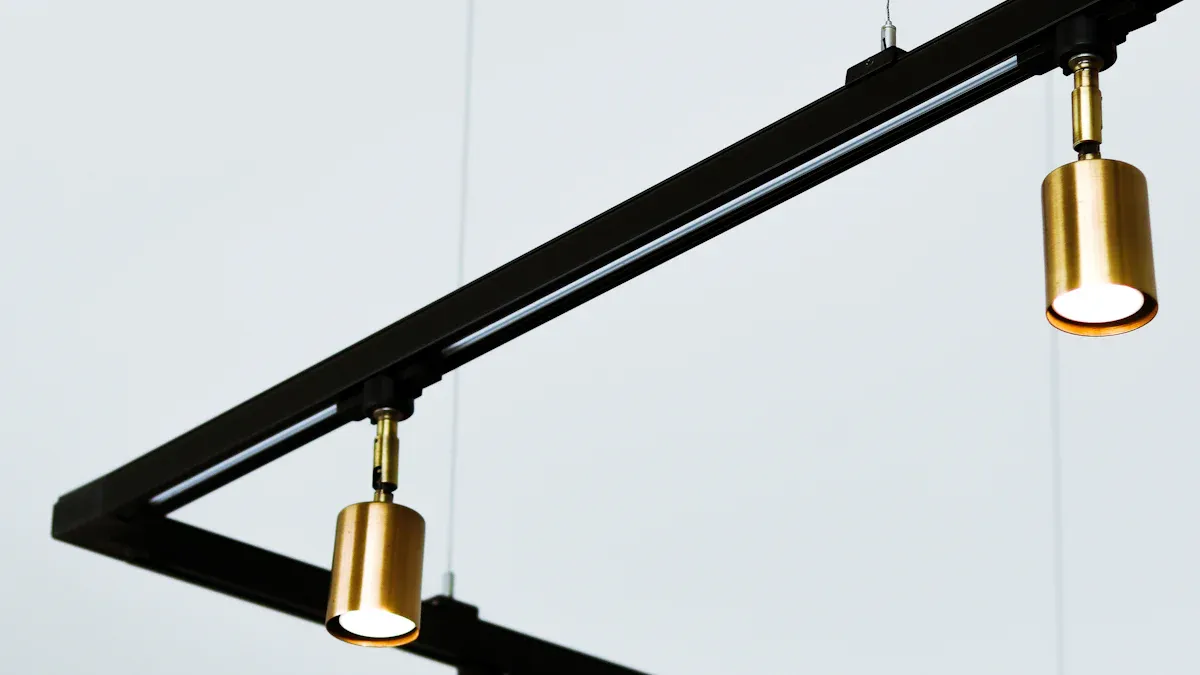Track LED Lighting: Systems, Installation, and Design Applications

Track LED lighting is an innovative solution that not only saves energy but also enhances aesthetics. It utilizes movable tracks to direct light precisely where you need it, making it incredibly versatile for various applications.
According to studies, LED lights have the potential to reduce global lighting electricity consumption by 40% by 2030. Additionally, high-quality LED bulbs consume 75% less energy compared to traditional bulbs.
At About Us, we offer a range of products that feature track LED lighting, perfect for homes, offices, and art spaces. You can easily adjust the LED lights to improve functionality and elevate the overall appearance of your environment.
Key Takeaways
Track LED lights save energy and make spaces look better. They use up to 75% less electricity than regular bulbs.
Pick a track lighting system that fits your needs. Single-circuit systems are easy, but three-circuit systems let you control specific spots.
Installing track LED lights is simple. Get your tools, turn off the power, and follow clear steps to set them up safely.
Adjustable track LED lights work great in many places. Use them at home, in offices, or galleries to set the mood and highlight key areas.
Take care of track LED lights to keep them working well. Clean them softly and check for loose wires to make them last longer.
Understanding Track LED Lighting
What Is Track LED Lighting?
Track LED lighting is a modern way to light spaces. It uses a track to hold and power several lights. You can move and aim the lights as needed. This makes it great for many uses. It can brighten certain spots, set a mood, or highlight decorations. The track can go on ceilings or walls, giving you design options.
Unlike old lighting systems, track LED lighting saves energy and is easy to change. You don’t need major electrical work to move lights around. This makes it a smart choice for homes and businesses.
Key Features and Benefits
Track LED lighting has many useful features. Here are its main benefits:
Flexibility: Move, add, or take off lights on the track easily.
Cost-effectiveness: No need for expensive rewiring or extra fixtures.
Energy-saving: Uses less power and lasts longer than regular bulbs.
Adaptability: Adjusts to fit your specific lighting needs.
The table below shows how track LED lighting performs in key areas:
Metric | Description |
|---|---|
Energy Savings Percentage | Installations save 40% to 70% energy, helping the planet and cutting costs. |
Customer Satisfaction Score | Tracks how happy customers are with the product and its performance. |
Installation Efficiency | Measures how quickly and smoothly installations are done, saving time and effort. |
The demand for LED track lighting is growing fast. By 2032, the market could reach $7.05 billion, growing at 7.7% yearly. This shows more people want energy-saving and flexible lighting.
Why LED Technology Is Ideal for Track Lighting
LEDs are perfect for track lighting systems. They save energy, last long, and work well. LEDs use much less electricity, lowering bills. They can last up to 50,000 hours, so you won’t replace them often.
Here are more reasons why LEDs are great for track lighting:
Directional lighting: LEDs shine light exactly where you need it.
Lower heat emission: They stay cool, making rooms more comfortable.
High luminosity: They give bright, steady light for better visibility.
LEDs work well in many places, like homes, offices, and art spaces. Use them to light up art in galleries or make your living room cozy. Track LED lighting with LEDs can do it all.
Types of Track LED Lighting Systems

Single-Circuit Systems
Single-circuit systems are the easiest type to use. All the lights on the track turn on together. When you switch it on, every light lights up at once. This makes it perfect for places needing steady light, like kitchens or hallways.
These systems are simple to set up and take care of. They also cost less than other types. If you want basic lighting without extra controls, this is a good choice. Their neat design fits most rooms, giving a modern and clean look.
Three-Circuit Systems
Three-circuit systems are more flexible than single-circuit ones. You can control groups of lights separately. For example, you can turn on one group while leaving others off. This is great for stores or galleries to highlight certain spots.
Here’s a quick comparison of single-circuit and three-circuit systems:
Aspect | Single-Circuit Track Lighting | Three-Circuit Track Lighting |
|---|---|---|
Individual Fixture Control | All lights work together. | Control lights separately. |
Installation | Easier and takes less space. | Needs more space and effort to install. |
Cost | Cheaper option. | Costs more due to added features. |
Aesthetic Appearance | Slim and blends in well. | Bigger and looks more industrial. |
Flexibility and Customization | Limited options for lighting changes. | Offers more ways to adjust lighting. |
Though three-circuit systems cost more and take more work to install, they are worth it. You can create unique lighting setups to improve how your space looks and works.
Low Voltage Systems
Low voltage systems are another popular choice for track lighting. They use a transformer to lower the voltage to 12 or 24 volts. This makes them safer and saves energy. These systems are great for cozy spaces like bedrooms or living rooms.
A big advantage is their small, stylish light fixtures. These lights look modern and don’t stand out too much. Low voltage systems also save energy, helping you cut costs over time.
When picking a low voltage system, choose the right transformer and lights. Proper setup is important to keep the system safe and working well.
Mains Voltage Systems
Mains voltage systems use the regular electricity in your home, usually 120V or 240V. They don’t need a transformer, so they are easier to install and cost less. These systems work well in big spaces like living rooms, offices, or stores where you need bright light.
A great thing about mains voltage systems is their flexibility. You can use many types of fixtures and bulbs with them. This lets you design your lighting to fit your style. Plus, they work with dimmable LED bulbs, so you can change the brightness to set the mood.
When setting up a mains voltage system, make sure the track and fixtures match your area’s voltage. Installing it correctly is important for safety and good performance. If you’re not sure about the electrical setup, ask a licensed electrician for help to avoid any risks.
Choosing the Right System for Your Needs
Picking the best track LED lighting system depends on what you need. Think about these points to decide:
What type of track and fixtures fit your space?
How much light and wattage do you need?
What brightness and color will match your room’s feel?
Do you want lights that can dim for more control?
How should the design look and work in your space?
For example, if you want something simple and cheap, go for a single-circuit system. If you need more control, a three-circuit system is better for places like stores or galleries. Low voltage systems are great for small, cozy rooms. Mains voltage systems are best for big areas needing bright light.
By thinking about these factors, you can pick a system that works well and looks good. Track LED lighting is flexible and fits many needs, making it a great choice for any space.
Installing Track LED Lighting
Tools and Materials Needed
Before starting, gather all tools and materials. Being prepared makes the job easier and safer. Use this checklist:
Tools: Screwdriver, wire cutter, voltage tester, drill, ladder, gloves, and goggles.
Materials: LED track light kit, screws, mounting brackets, anchors, and electrical tape.
When choosing materials, think about these points:
Light Source: Pick LEDs because they last long and save energy.
Beam Angle: Narrow beams are good for displays. Wide beams work for general lighting.
Color Temperature: Warm tones feel cozy. Cool tones are better for work areas.
Steps to Install Track LED Lighting
Follow these steps to set up your track LED lighting properly:
Turn Off Power: Switch off power at the breaker to stay safe. Use a voltage tester to check no electricity is running.
Mark and Drill: Measure and mark where the track will go. Drill holes for screws.
Attach the Track: Secure the track to the ceiling or wall with screws and anchors. Make sure it’s tight.
Wire the Track: Match wires by color—black to black, white to white. Wrap connections with electrical tape.
Add Fixtures: Clip the light fixtures onto the track. Move them to aim the light where needed.
Test the Lights: Turn the power back on. Check if the lights work correctly.
Step | What to Do |
|---|---|
1 | Turn off power at the breaker. |
2 | Mark and drill holes for screws. |
3 | Secure the track in place. |
4 | Connect wires by matching colors. |
5 | Attach fixtures to the track. |
Safety Tips for Installation
Always stay safe when working with electricity. Keep these tips in mind:
Turn off the power before starting.
Use a voltage tester to double-check no electricity is flowing.
Wear gloves and goggles to protect yourself.
Don’t overload the track with too many lights. Check the wattage limit.
If unsure about wiring, ask an electrician for help.
By following these steps and safety tips, you can install track LED lighting safely and easily.
Troubleshooting Common Installation Issues
Sometimes, problems happen during or after setting up track LED lighting. Fixing these issues helps your lights work better and last longer. Below are common problems and how to solve them.
Common Problems | Solutions |
|---|---|
Wrong LED Light Setup | Plan carefully to avoid loose wires, overloads, or uneven lighting. |
Using Incorrect Voltage or Current | Use the right voltage and current to stop flickering or overheating. |
Overheating Issues | Improve airflow, lower wattage, and use good heat sinks to cool lights. |
Key Troubleshooting Tips
Tighten Loose Wires: Loose wires can make lights flicker or stop working. Check and secure all wires tightly.
Match Voltage Correctly: Wrong voltage can harm your LEDs. Always use the voltage your fixture needs.
Prevent Overheating: Poor airflow or high wattage causes overheating. Use LEDs with heat sinks to keep them cool.
💡 Pro Tip: Properly installed LEDs can last up to 50,000 hours. Use quality parts and follow setup steps to avoid problems.
Common Problems to Watch For
Bad setups may cause uneven lighting or loose fixtures.
Voltage mistakes can make lights flicker or wear out faster.
Overheating happens if lights are too close to ceilings or lack airflow.
Fixing these problems early keeps your track LED lighting working well. Good installation and regular care save time and money later.
Design Applications of Track LED Lighting

Residential Spaces: Improving Kitchens, Living Rooms, and Bedrooms
Track LED lighting makes homes look better and work well. In kitchens, bright lights help you see clearly while cooking. You can aim lights at counters or shelves to highlight them. Adjustable lights also make dining tables or decorations stand out.
Living rooms feel cozy with soft lighting that sets a warm mood. Accent lights can show off special features like fireplaces or art pieces. In bedrooms, dimmable lights create a relaxing space. You can change the brightness to match your mood or activity.
Type of Lighting | What It Does | Why Use LED Lighting |
|---|---|---|
Ambient Lighting | Lights up the whole room and sets the mood. | Makes living rooms feel warm and welcoming. |
Task Lighting | Brightens areas for specific activities. | Helps in kitchens and workspaces. |
Accent Lighting | Focuses on special features like art or decorations. | Adjustable lights add visual interest. |
Decorative Lighting | Adds style and flair to your space. | LEDs save energy and last longer. |
Using track LED lighting makes your home look great and saves energy.
Commercial Spaces: Stores, Offices, and Restaurants
Track LED lighting is important for businesses. Stores use it to make products look better and attract customers. Adjustable lights can shine on displays to grab attention. Offices benefit from energy-saving lights that lower costs and keep spaces professional.
Restaurants use dimmable lights to create a cozy dining feel. Bright lights are used in kitchens for better visibility. Businesses can also save energy with smart controls that adjust lights based on use. This reduces waste and keeps spaces well-lit.
Metric | What It Means |
|---|---|
Lumen Ratings | Higher numbers mean brighter lights and more energy savings. |
Wattage | LEDs use less power than older bulbs. |
Energy Savings | Businesses save money and may get rebates for using LEDs. |
Track LED lighting helps businesses look good and save money.
Artistic Spaces: Galleries, Studios, and Creative Areas
Art spaces need lighting that can be adjusted easily. Track LED lighting works well here because it can focus light where needed. In galleries, it highlights art so every detail is clear. Studios use bright lights for tasks like painting or crafting.
One spa project showed how LED lights improve creative spaces. Color-changing LEDs lit up pools and counters, showing their flexibility. These lights used less energy than regular ones, proving their efficiency. The spa looked amazing, showing how LEDs can improve both design and function.
Track LED lighting helps you create beautiful and energy-saving art spaces.
Tips for Making Your Space Look Great and Work Well
To make the most of your track LED lighting, balance looks and usefulness. Follow these tips to create a space that’s both stylish and practical:
Plan Your Lighting Layout
Draw your room and mark where light is needed most. Focus on areas like desks, seating spots, or art pieces. A good plan gives even light and avoids shadows.Pick the Right Light Color
Choose a color that fits your room’s mood. Warm white (2700K–3000K) feels cozy, great for bedrooms or living rooms. Cool white (4000K–5000K) is brighter, better for kitchens or offices.Use Dimmable Lights for Control
Dimmable LEDs let you change brightness as needed. Use bright light for work or dim it for relaxing. This adds both comfort and flexibility.Adjust Angles and Heights
Aim lights to highlight things like art, shelves, or special features. Changing fixture heights can also make your room look more interesting.
💡 Pro Tip: Combine ambient, task, and accent lighting for layers. This makes your room feel lively and well-planned.
Keep It Simple
Don’t add too many lights to the track. A simple design looks modern and keeps the space neat.
By using these tips, your track LED lighting can be both functional and stylish. Whether it’s for a cozy home or a professional area, smart design choices make a big difference. 😊
Track LED lighting is flexible and efficient, making it great for modern spaces. It saves energy, lasts long, and works in homes, businesses, and art areas. The table below shows how it’s better than old incandescent lights:
Feature | LED Lighting | Incandescent Lighting |
|---|---|---|
Energy Efficiency | Uses 75% less energy | Wastes 90% of energy as heat |
Lifespan | Lasts 25 times longer | Only lasts about 1,000 hours |
Heat Emission | Stays cool with little heat | Gets very hot |
Applications | Works in many places | Limited uses |
Adoption Rate | Becoming more popular everywhere | Losing popularity |
Energy Savings Potential | Could save lots of energy by 2035 | Not energy-saving |
Studies prove its usefulness in different settings. For example, Hurlbert and Cuttle (2020) found it perfect for museums. Zhai et al. (2016) showed its color is great for both seeing clearly and feeling cozy. These studies show how it improves both looks and function.
Now is a great time to try track LED lighting. Whether for your home, business, or art space, it’s a smart choice. It gives you the flexibility and energy savings to make your ideas shine. 😊
FAQ
How long do LED track lights last?
LED track lights can last up to 50,000 hours. This means they work for many years without needing to be replaced. Their long life makes them a smart and money-saving choice for homes, offices, and other places.
Can I put up track LED lighting by myself?
Yes, you can install it yourself if you follow the steps. Gather the tools, turn off the power, and connect wires correctly. If you’re not sure about wiring, ask an electrician to help you stay safe.
Are track LED lights able to dim?
Many track LED lights can dim. You just need to use them with the right dimmer switches. This lets you change the brightness to match your mood or activity.
How should I clean and take care of track LED lights?
Use a soft, dry cloth to wipe the lights and track. Don’t use water or strong cleaners. Check for loose wires or dust often to keep the lights working well and lasting longer.
Can track LED lights be used outside?
Some track LED lights are made for outdoor use. Look for ones that are waterproof or weatherproof. These lights can brighten patios, gardens, or paths while handling outdoor weather.
See Also
Expert Design and Installation of Flood Lighting Solutions
Effective Integration Techniques for Light Commercial Electrical Systems
Essential Insights on LED Area Lights: Types and Uses
Understanding LED Area Lights: Uses, Advantages, and Setup Tips
Exploring Recessed Lighting: Varieties, Setup, and Design Tips

